Coordinated Development of Urban Agglomeration in Central Shanxi
Abstract
:1. Introduction
2. Overview of the Study Area
3. Research Method
3.1. Modified Gravity Model
3.2. Industrial Structure Similarity Coefficient
3.3. Population–Economic Growth Elasticity
4. Research Results
4.1. Level of Coordinated Economic Development
4.1.1. Urban Economic Quality
4.1.2. Strength Analysis of Economic Linkages
4.2. Industrial Coordinated Development Level
4.3. Population–Economic Coordinated Development Level
5. Analysis and Discussion
5.1. Analysis
5.1.1. Poor Level of Coordinated Economic Development
5.1.2. Strong Dependence on Industrial Coal Resources
5.1.3. Population Development and Economic Growth Are Not Coordinated
5.2. Discussion
5.2.1. Strengthening Economic Planning and Improving Economic Development
5.2.2. Optimizing and Upgrading Industrial Structure and Eliminating Coal Dependency
5.2.3. Strengthen Regional Ties and Improve the Level of Population Economic Coordination
6. Conclusions
Author Contributions
Funding
Institutional Review Board Statement
Informed Consent Statement
Data Availability Statement
Conflicts of Interest
Appendix A. Explanation of Some Nouns
- ① spatial combination model:
- From the perspective of space, the urban and industrial elements of urban agglomeration are reasonably arranged in space, which makes the urban agglomeration infrastructure, industrial structure, government regulation and economic policy achieve the optimal effect in space.
- ② 14th Five-Year Plan:
- The five-year plan is an important part of China’s long-term national economic plan; it mainly makes plans for major national construction projects, productivity distribution and important proportion relations of the national economy, and sets goals and directions for the development prospect of the national economy; it is now the fourteenth five-year plan period, referred to as the 14th five-year plan.
- ③ the central region:
- China’s central region refers to Shanxi, Henan, Anhui, Hubei, Jiangxi and Hunan provinces, Shanxi Province is in the northernmost central region.
- ④ the second step:
- China is divided into three steps according to altitude, mountains and topography, and each step has a different altitude. The highest elevation, above 4000 m, is the first step, the representative area is the Qinghai–Tibet Plateau; followed by the second step, 1000–2000 m, representing the Loess Plateau; the third step is below 500 m, represented by the middle and lower reaches of the Yangtze River plain.
- ⑤ the Golden Triangle of the Great Wall of Inner Mongolia, Shanxi, and Henbei:
- The Golden Triangle Cooperation Zone of the Great Wall of Mongolia, Shanxi and Hebei Province refers to the Ulanqab of Inner Mongolia Autonomous Region, Datong of Shanxi Province and Zhangjiakou of Hebei Province. The implementation of regional cooperation in the border area of the three provinces creates a cooperative and open platform for the coordinated development of the economy and society in the border area of the three provinces.
- ⑥ the Golden Triangle of the Yellow River:
- Yuncheng, Linfen, Sanmenxia, Henan Province and Weinan, Shaanxi Province, constitute the’ Yellow River Golden Triangle Area’ on the edge of Shanxi, Shaanxi and Henan Provinces.
References
- Yao, S.M.; Chen, S.; Chen, Z.G. New recognition on city group basic concept. Mod. Urban Res. 1998, 6, 15–17+61. [Google Scholar]
- Fang, C.L. Progress and the future direction of research into urban agglomeration in China. Acta Geogr. Sin. 2014, 69, 1130–1144. [Google Scholar]
- Fang, C.L. Research Progress and General Definition about Identification Standards of Urban Agglomeration Space. Urban Planning Forum. 2009, 4, 1–6. [Google Scholar]
- Fang, C.L.; Zhang, G.Y.; Xue, D.S. High-quality development of urban agglomerations in China and construction of science and technology collaborative innovation community. Acta Geogr. Sin. 2021, 76, 2898–2908. [Google Scholar]
- Gao, X.-L.; Xu, Z.-N.; Niu, F.-Q.; Long, Y. An evaluation of China’s urban agglomeration development from the spatial perspective. Spat. Stat. 2017, 21, 475–491. [Google Scholar] [CrossRef]
- Ding, R.Z.; Xu, B.Y.; Zhang, H. Can Urban Agglomeration Drive Regional Economic Growth? Empirical Analysis Based on Seven State-level Urban Agglomerations. Econ. Geogr. 2021, 41, 37–45. [Google Scholar]
- Bettencourt, L.M.A.; Lobo, J.; Strumsky, D. Invention in the city: Increasing returns to patenting as a scaling function of metropolitan size. Res. Policy 2006, 36, 107–120. [Google Scholar] [CrossRef]
- Bettencourt Luís, M.A.; Lobo, J. Urban scaling in Europe. J. R. Soc. Interface 2016, 13, 20160005. [Google Scholar] [CrossRef]
- Guo, S.; Jiang, L.; Zhang, H.O.; Ye, Y.Y.; Lin, H.X. The Functional Coordinated Development of Urban Agglomer-ation from the Perspective of Flow Space: A Case Study of San Francisco Bay Area. Trop. Geogr. 2022, 42, 195–205. [Google Scholar]
- Hu, Y.; Tang, L.; Can, H. Influence of Competition and Cooperation between Intercity of Urban Agglomeration on Urban Economic Development—Empirical Test on Urban Agglomeration of Yangtze River Delta Based on the Perspective of Spatial Spillover. West Forum 2018, 28, 76–83. [Google Scholar]
- Sun, Z.R.; Fan, J.; Sun, Y. Research on Spatial and Temporal Evolution of Cooperative Innovation Network in Chengdu-Chongqing Urban Agglomeration from the Perspective of Intra Group and Inter Group. Areal Res. Dev. 2022, 41, 26–31+44. [Google Scholar]
- Zhang, J.W.; Du, D.B. Study on the Model of Inter-city Cooperation based on the Evolutionary Theory. Urban Dev. Stud. 2011, 18, 82–88. [Google Scholar]
- Peng, J.; Lin, H.; Chen, Y.; Blaschke, T.; Luo, L.; Xu, Z.; Hu, Y.; Zhao, M.; Wu, J. Spatiotemporal evolution of urban agglomerations in China during 2000–2012: A nighttime light approach. Landsc. Ecol. 2020, 35, 421–434. [Google Scholar] [CrossRef]
- Fan, Y.; Guo, R.; He, Z.; Li, M.; He, B.; Yang, H.; Wen, N. Spatio–Temporal Pattern of the Urban System Network in the Huaihe River Basin Based on Entropy Theory. Entropy 2019, 21, 20. [Google Scholar] [CrossRef] [Green Version]
- Zhao, Z. Characteristics Analysis and Optimization Strategy of Logistics Network in Yangtze River Delta Urban Agglomeration. Int. Core J. Eng. 2021, 7, 653–662. [Google Scholar]
- Li, J.; Qiu, R.; Xiong, L.; Xu, J.D. A gravity-spatial entropy model for the measurement of urban sprawl. Sci. China Earth Sci. 2016, 59, 207–213. [Google Scholar] [CrossRef]
- Liang, S. Research on the Urban Influence Domains in China. Int. J. Geogr. Inf. Sci. 2009, 23, 1527–1539. [Google Scholar] [CrossRef]
- Matsumoto, H.; Domae, K. Assessment of competitive hub status of cities in Europe and Asia from an international air traffic perspective. J. Air Transp. Manag. 2019, 78, 88–95. [Google Scholar] [CrossRef]
- Li, P.; Lv, Y.; Yao, D. Calculation and Analysis of Synergy Potential of Exhibition Economy in the PRD Urban Agglomerations. Mod. Econ. 2017, 8, 1580–1593. [Google Scholar] [CrossRef] [Green Version]
- Su, D.; Fang, X.; Wu, Q.; Cao, Y. Exploring the Spatiotemporal Integration Evolution of the Urban Agglomeration through City Networks. Land 2022, 11, 574. [Google Scholar] [CrossRef]
- Zhou, S.H.; Hao, X.H.; Liu, L. Validation of spatial decay law caused by urban commercial center′s mutual attraction in polycentric city: Spatio-temporal data mining of floating cars’ GPS data in Shenzhen. Acta Geogr. Sin. 2014, 69, 1810–1820. [Google Scholar]
- Wang, D.Z.; Zhuang, R.X. The preliminary probe into the quantitative analysis of regional economic links-A Case Study on Economic Links between Su-Xi-Chang and Shanghai. Sci. Geogr. Sin. 1996, 16, 51–57. [Google Scholar]
- Liang, Y.Q.; Hui, W.D. Influence of plateau environment on automobile engine performance. Intern. Combust. Engine Parts 2021, 15, 69–70. [Google Scholar]
- Zhang, X.C.; Liu, Q.; Chen, S.Q.; Wang, W.K.; Luan, X.F. Measuring Economic Intergration of City Region:A Case Study of Shenzhen-Dongguan-Huizhou Sub-region. Urban Dev. Stud. 2019, 26, 18–28. [Google Scholar]
- Liu, J.; Gao, T.B. AHP-SWOTA analysis of Northeast Economics of Scale Development Strategy Undertaking New Economic Situation. J. Northeast. Norm. Univ. (Philos. Soc. Sci.) 2022, 2, 111–127+147. [Google Scholar]
- Lian, X.M.; Wu, J.H. Dynamics of Spatial Pattern between Population and Economies in Northeast China. Popul. J. 2018, 40, 45–55. [Google Scholar]
- Bai, X.; Guan, Y.M. The Evolution of the Spatial Pattern of Population and Economy in the GuangdongHong Kong-Macao Greater Bay Area. Geomat. World 2020, 27, 68–74+80. [Google Scholar]
- Liu, X.L.; Cui, L.L.; Li, B.; Du, X.W. Research on the High-quality Development Path of China’s Energy Industry under the Target of Carbon Neutralization. J. Beijing Inst. Technol. (Soc. Sci. Ed.) 2021, 23, 1–8. [Google Scholar]
- Zou, X.; Wang, P. Study on the Mechanism of Industrial Structure Adjustment on the Optimization of Energy Consumption Structure. Soft Sci. 2019, 33, 11–16. [Google Scholar]
- Wang, Q.; Yin, X.B. Research on the Impact of Technological Innovation and Industrial Structure Upgrading on Energy Consumption—A Case of the Yangtze River Delta. J. Ind. Technol. Econ. 2022, 41, 107–112. [Google Scholar]
- Shi, M.Y.; Shen, K.R. Research on Economic Growth and Spatial Spillover Effect of Talent Introduction Policy Tools—A Case Study of Yangtze River Delta. Inq. Into Econ. Issues 2022, 1, 32–49. [Google Scholar]
- Liang, R.W.; Wang, Z.B.; Fang, C.L.; Sun, Z. Spatiotemporal differentiation and coordinated development pattern of urbanization and the ecological environment of the Beijing-Tianjin-Hebei urban agglomeration. Acta Ecol. Sin. 2019, 39, 1212–1225. [Google Scholar]
- Kuang, W.H.; Yang, T.R.; Yan, F.Q. Regional urban land-cover characteristics and ecological regulation during the construction of Xiong’an New District, Hebei Province, China. Acta Geogr. Sin. 2017, 72, 947–959. [Google Scholar]
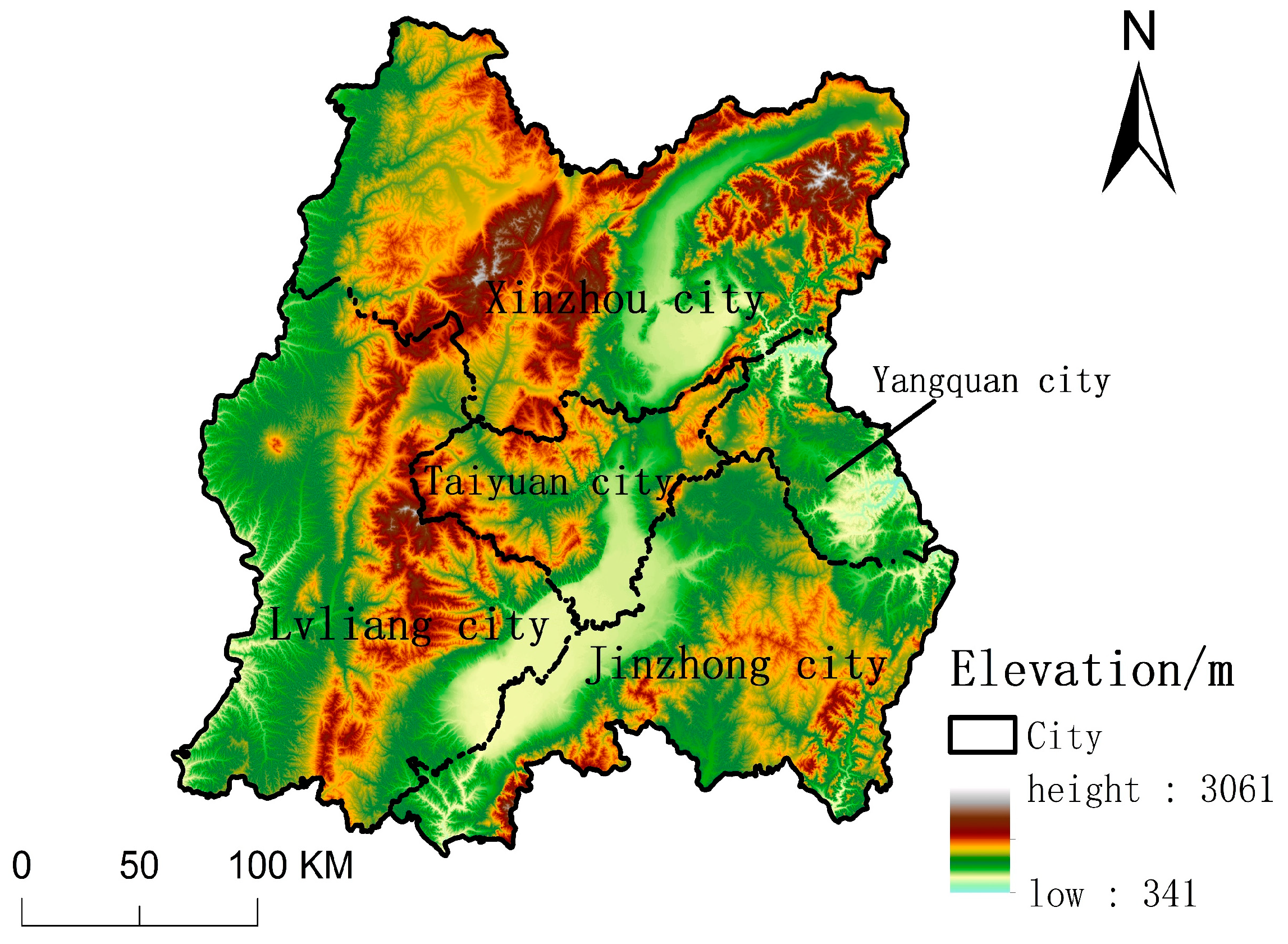
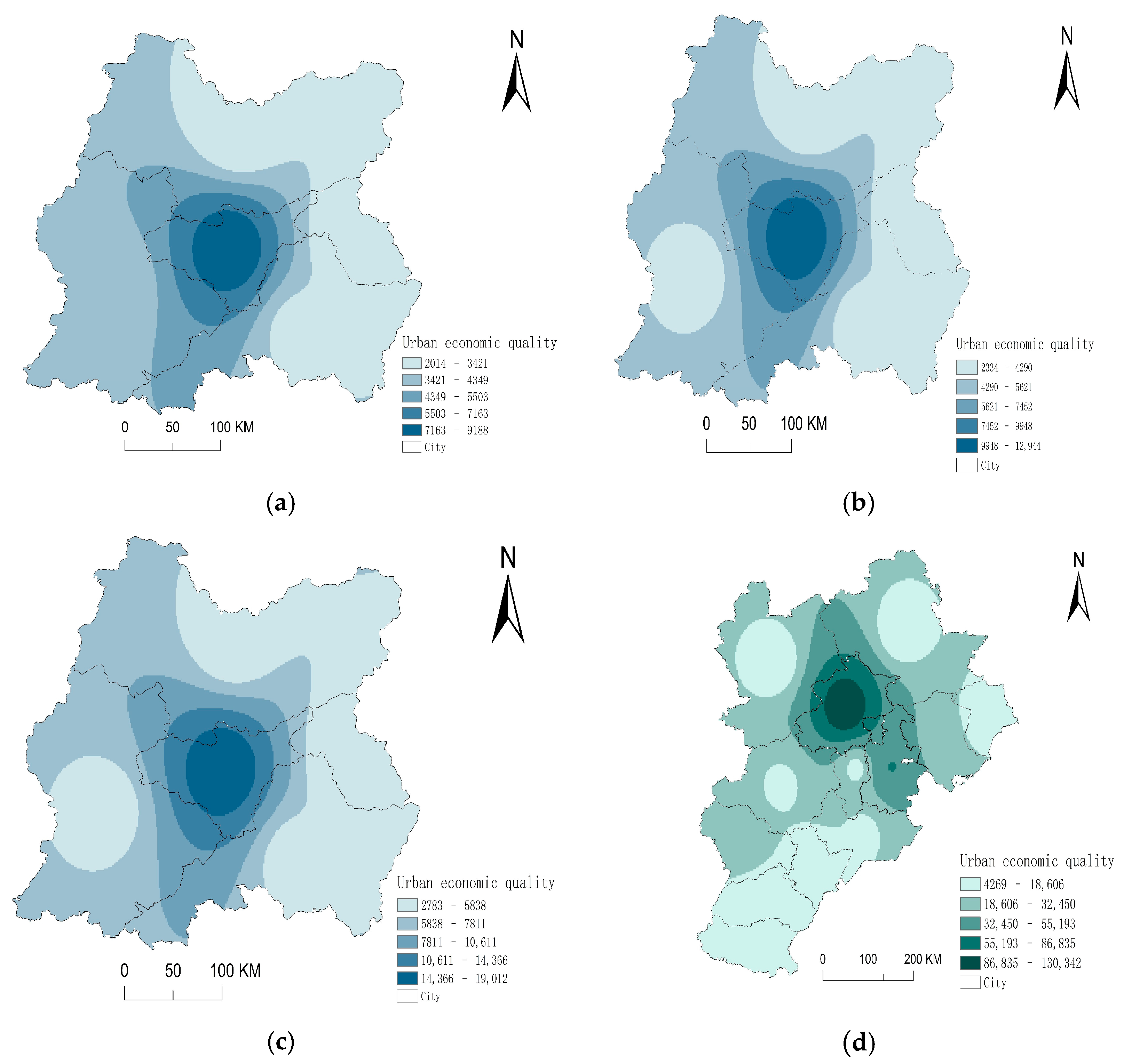
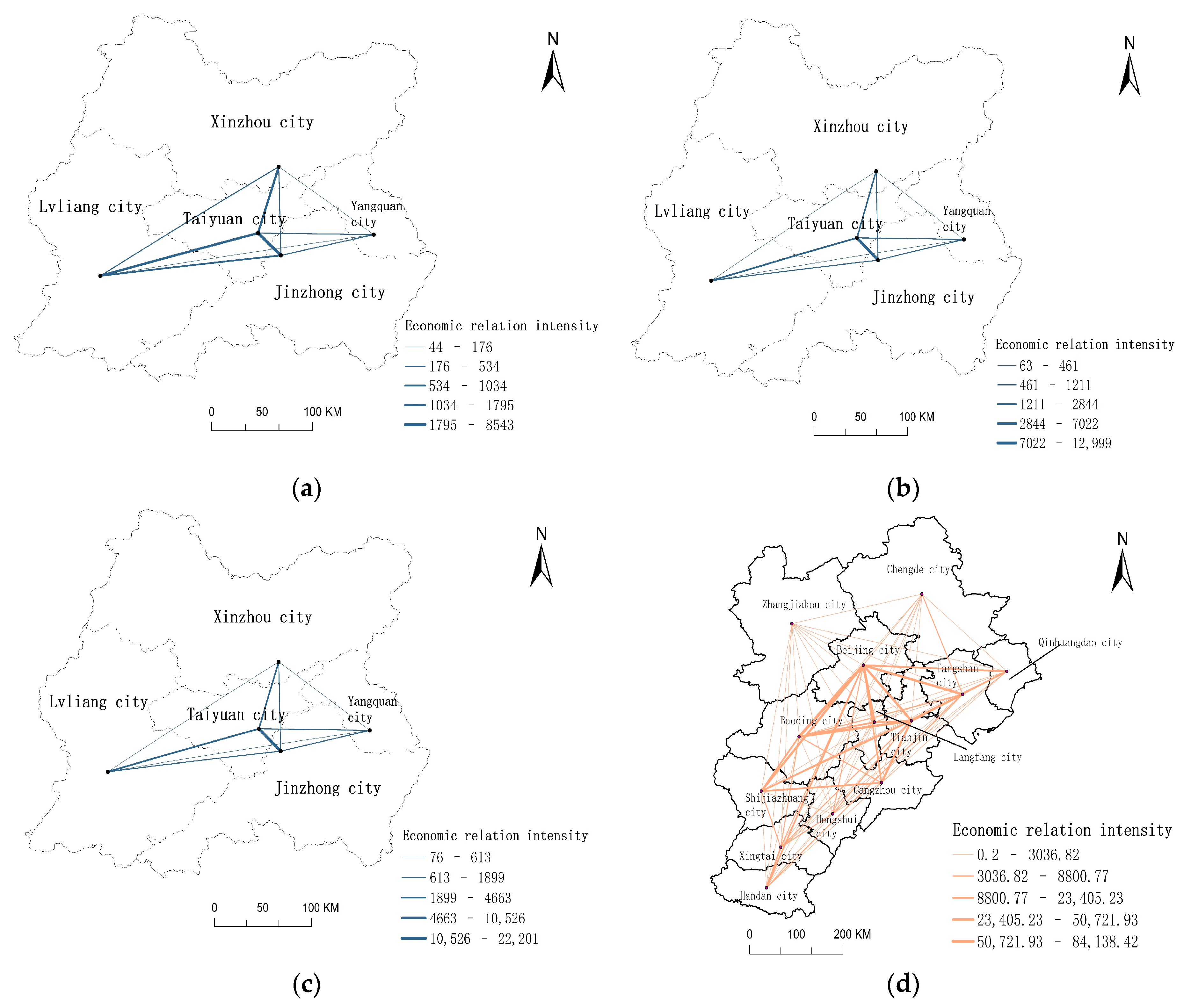
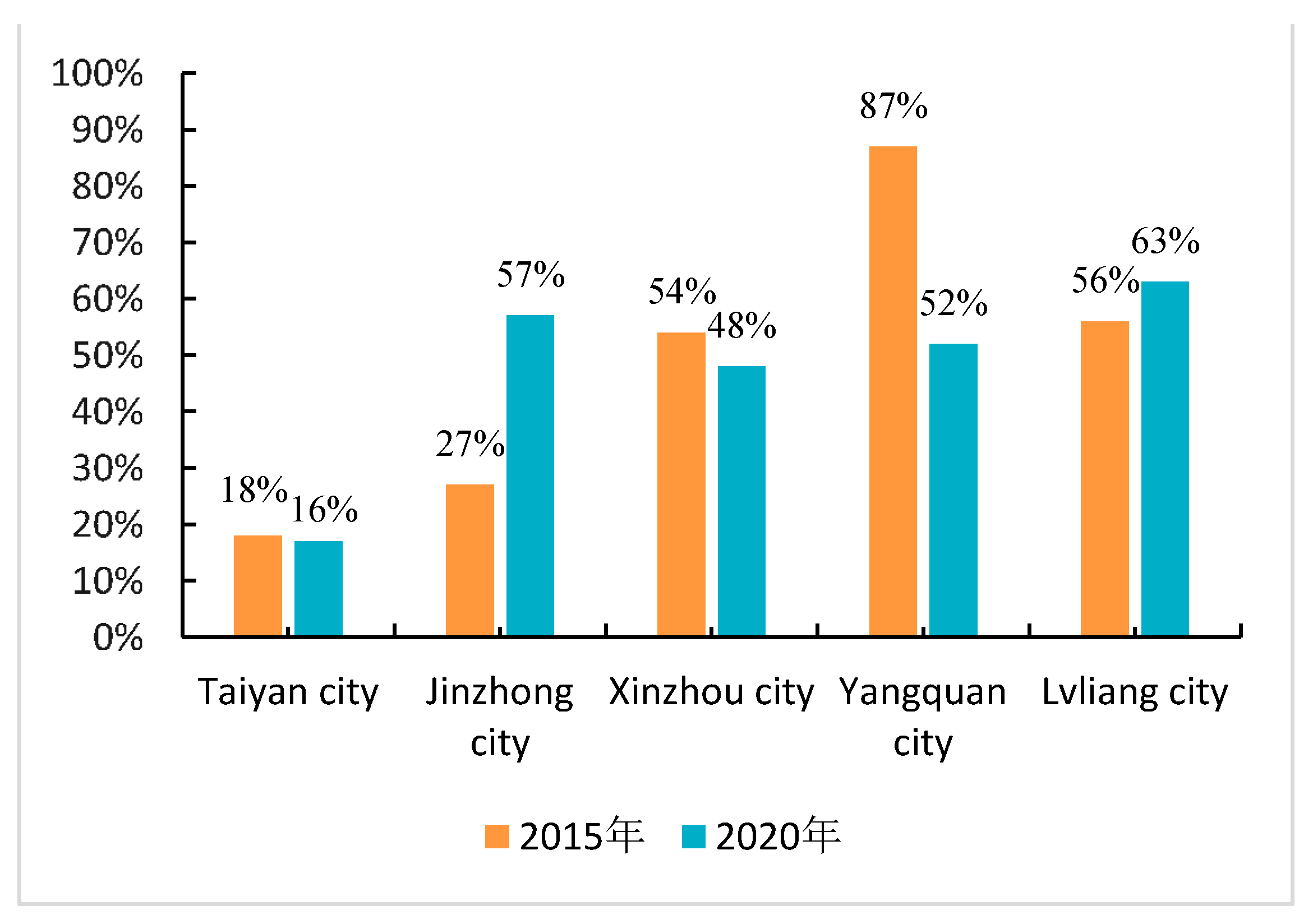
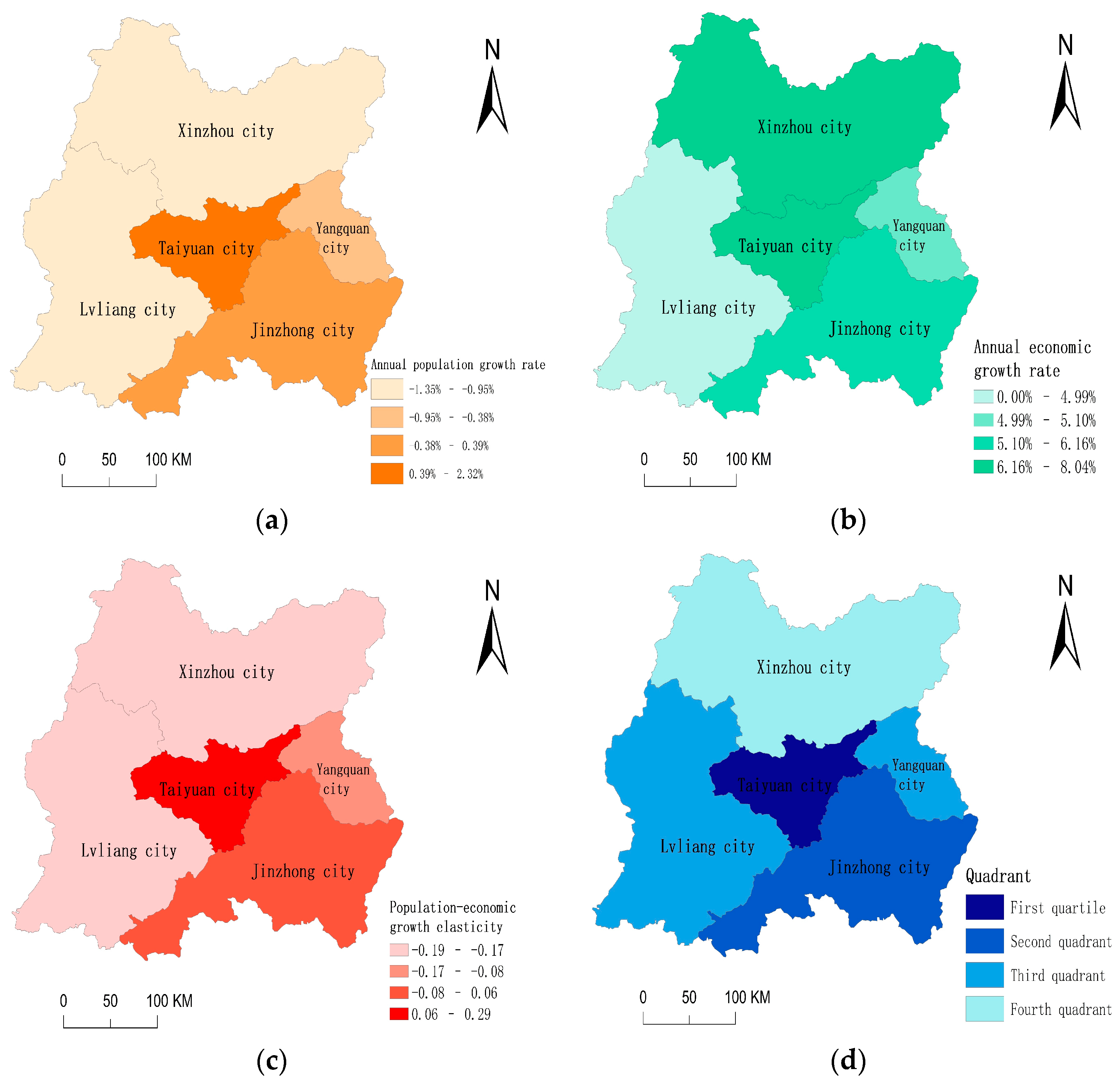
| Urban Agglomeration | Urban Population 2020 (Millions) | Total Urban Economy in 2020 (CNY Billion) | The Output of the Tertiary Industry in 2020 (CNY Billion) | Total Export-Import Volume in 2020 (CNY Million) | Disposable Income in 2020 (CNY Yuan) | Urban Economic Quality in 2020 | |
|---|---|---|---|---|---|---|---|
| Central Shanxi | Taiyuan | 531.85 | 4153.25 | 2616.83 | 12,114,678.00 | 35,473.00 | 19,012.22 |
| Jinzhong | 338.04 | 1468.77 | 689.84 | 200,152.00 | 26,187.00 | 4475.30 | |
| Xinzhou | 268.35 | 1034.56 | 501.83 | 188,696.00 | 19,637.00 | 3487.97 | |
| Yangquan | 131.79 | 742.24 | 397.34 | 150,488.00 | 28,529.00 | 2782.77 | |
| Lüliang | 339.45 | 1538.04 | 547.02 | 383,983.00 | 19,387.00 | 4629.29 | |
| Beijing–Tianjin–Hebei | Beijing | 2189.00 | 36,102.60 | 30,278.60 | 226,436,784.00 | 69,434.00 | 130,343.04 |
| Tianjin | 1386.60 | 14,083.73 | 9069.47 | 71,594,526.00 | 43,854.00 | 56,108.41 | |
| Shijiazhuang | 1123.51 | 5935.10 | 3691.32 | 13,411,470.54 | 30,954.84 | 25,227.73 | |
| Chengde | 335.44 | 1550.30 | 716.47 | 163,367.25 | 23,222.56 | 4266.41 | |
| Zhangjiakou | 411.89 | 1600.10 | 901.44 | 391,100.12 | 25,673.71 | 5690.21 | |
| Qinhuangdao | 313.69 | 1685.80 | 901.41 | 3,590,551.60 | 28,417.46 | 8657.53 | |
| Tangshan | 771.80 | 7210.90 | 2780.75 | 10,210,667.25 | 34,871.00 | 22,296.40 | |
| Langfang | 546.41 | 3301.10 | 2057.64 | 3,924,196.07 | 34,357.62 | 13,799.52 | |
| Baoding | 1154.40 | 3954.30 | 2140.90 | 2,937,364.90 | 25,204.37 | 14,855.64 | |
| Cangzhou | 730.08 | 3699.87 | 1951.15 | 3,183,137.16 | 26,887.73 | 13,516.10 | |
| Hengshui | 421.29 | 1560.20 | 835.55 | 2,353,981.33 | 23,527.33 | 7881.75 | |
| Xingtai | 711.11 | 2200.40 | 1065.54 | 1,698,288.48 | 23,772.07 | 9238.85 | |
| Handan | 941.40 | 3636.60 | 1688.65 | 2,116,951.81 | 26,918.55 | 12,692.71 |
| Taiyuan | Jinzhong | Xinzhou | Yangquan | Lüliang | |
|---|---|---|---|---|---|
| Taiyuan | 1.00 | ||||
| Jinzhong | 0.17 | 1.00 | |||
| Xinzhou | 0.10 | 0.23 | 1.00 | ||
| Yangquan | 0.08 | 0.24 | 0.22 | 1.00 | |
| Lüliang | 0.21 | 0.30 | 0.24 | 0.33 | 1.00 |
| Taiyuan | Jinzhong | Xinzhou | Yangquan | Lüliang | |
|---|---|---|---|---|---|
| Taiyuan | 1.00 | ||||
| Jinzhong | 0.11 | 1.00 | |||
| Xinzhou | 0.07 | 0.13 | 1.00 | ||
| Yangquan | 0.13 | 0.19 | 0.34 | 1.00 | |
| Lüliang | 0.11 | 0.20 | 0.19 | 0.37 | 1.00 |
| Annual Population Growth Rate | Annual Economic Growth Rate | Population– Economic Growth Elasticity | |
|---|---|---|---|
| Taiyuan | 2.32% | 8.04% | 0.29 |
| Jinzhong | 0.39% | 6.16% | 0.06 |
| Xinzhou | −1.35% | 7.98% | −0.17 |
| Yangquan | −0.38% | 5.10% | −0.08 |
| Lüliang | −0.95% | 4.99% | −0.19 |
Publisher’s Note: MDPI stays neutral with regard to jurisdictional claims in published maps and institutional affiliations. |
© 2022 by the authors. Licensee MDPI, Basel, Switzerland. This article is an open access article distributed under the terms and conditions of the Creative Commons Attribution (CC BY) license (https://creativecommons.org/licenses/by/4.0/).
Share and Cite
Cao, Y.; Zhang, Z.; Fu, J.; Li, H. Coordinated Development of Urban Agglomeration in Central Shanxi. Sustainability 2022, 14, 9924. https://doi.org/10.3390/su14169924
Cao Y, Zhang Z, Fu J, Li H. Coordinated Development of Urban Agglomeration in Central Shanxi. Sustainability. 2022; 14(16):9924. https://doi.org/10.3390/su14169924
Chicago/Turabian StyleCao, Yongjian, Zhongwu Zhang, Jie Fu, and Huimin Li. 2022. "Coordinated Development of Urban Agglomeration in Central Shanxi" Sustainability 14, no. 16: 9924. https://doi.org/10.3390/su14169924
APA StyleCao, Y., Zhang, Z., Fu, J., & Li, H. (2022). Coordinated Development of Urban Agglomeration in Central Shanxi. Sustainability, 14(16), 9924. https://doi.org/10.3390/su14169924






